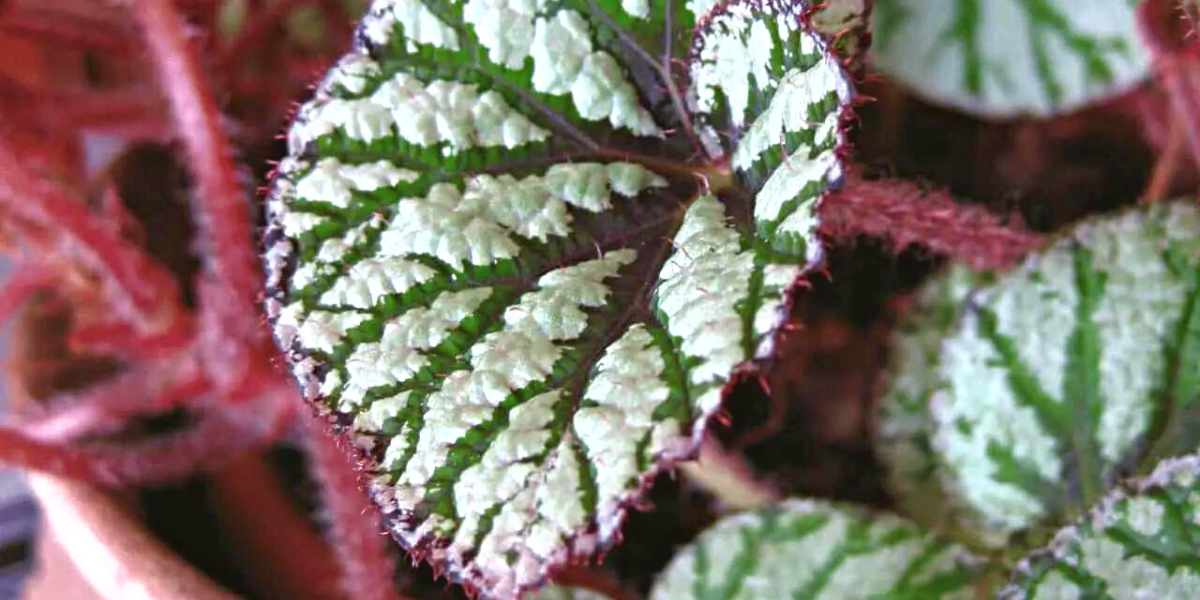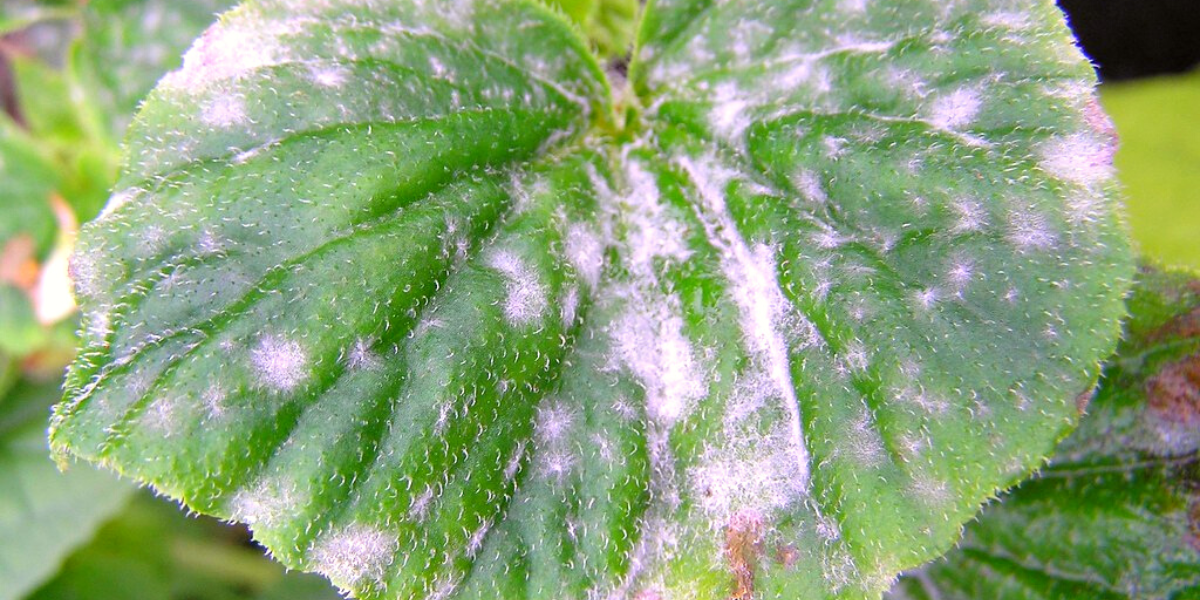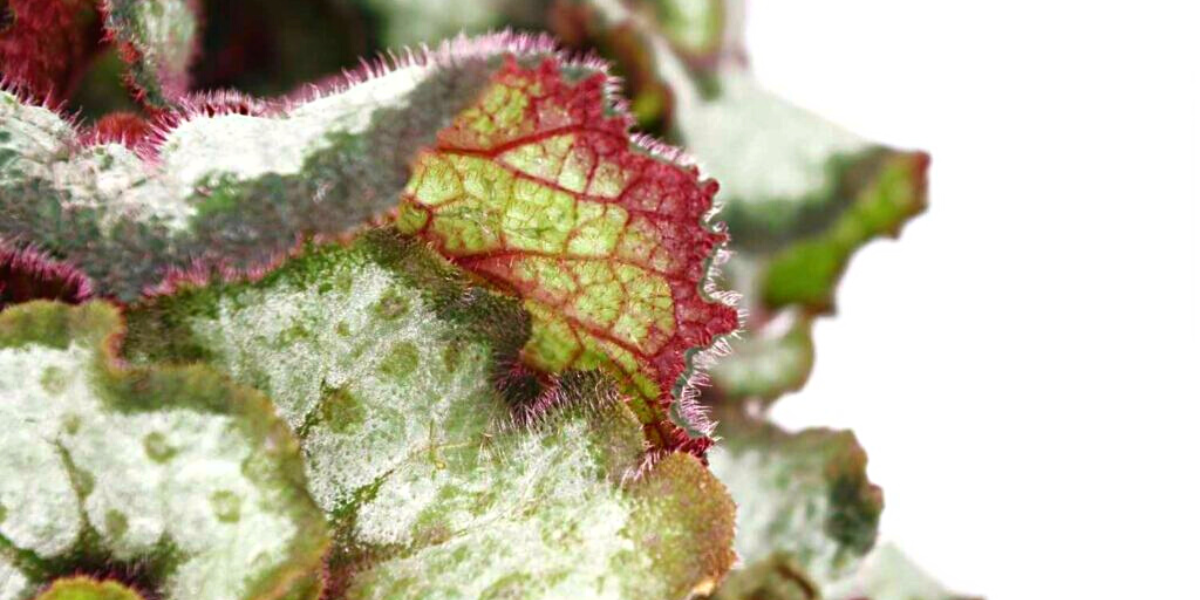It’s safe to say few perennials are as ubiquitously welcome as begonias are. Their lush green looks amazingly good in hanging baskets as well as in the ground, and the fact that they like a shady garden makes them even more valuable as an ornamental plant. While begonias are generally on the more accessible side of the spectrum when it comes to care, you might some ugly white or off-white spots or blotches on their leaves sooner or later. These are the telltale signs of the so-called powdery mildew, the begonia-targeting type of widespread yet frustrating disease.
This article focuses on the causes and effects of powdery mildew in begonias. You will learn how to differentiate it from other plant diseases that can affect this flower and what steps you can take to prevent its transmission to other plants, whether in a garden or inside a greenhouse. Be sure to read this guide if you are facing unsightly changes on the leaves and stems of your begonias or want to be prepared in case they appear.
What Causes Mildew on Begonias
Our knowledge of how mildew works has evolved over the past decades and even years, and the powdery variety is no exception. At least now you don’t need to try one bactericidal agent after another in hopeless attempts to kill non-existing bacteria while the real culprit belongs to the Fungi kingdom.
According to the most general classification, all living beings fall into five categories, including plants, animals, prokaryotes, single-celled eukaryotes, and fungi. The latter kingdom consists of the mysterious creatures that we know as mushrooms as well as mould and mildew species. In case you’ve been wondering about the difference between the two, it mainly lies in the color since mildew tends to be lighter, while the term “mould” is typically used for brown, purple, or black-looking colonies.

There are a number of begonia diseases that are caused by pathogenic fungi, and knowing which of these you are dealing with is crucial to identifying appropriate control measures. The powdery variety is arguably the most notorious of these conditions and is relatively common. Below is a more detailed overview of why it might be affecting your begonias.
Begonia powdery mildew
The name of the specific mildew that causes white powder on begonia leaves with a downy growth on them is Erysiphe cichoracearurn. What you see on affected leaves and stems is nothing by its mycelium, which is the term for a fungus’s root-like structure, as well as spores. Powdery mildew relies on these spores for transmission and reproduction. They can become windborne when the time comes, traveling to other plants in your garden and starting new colonies there.
This disease is found in a wide variety of garden plants beside begonias. However, those are typically caused by other fungi. Erysiphe cichoracearurn is the universal culprit when it comes to powdery fungal growth in begonias, that is, begonia maculata powdery mildew is no different from that on begonia rex.
Like many mildew species, Erysiphe cichoracearurn prefers moist, shady locations where the temperature fluctuates within 70 to 75 degrees Fahrenheit. It makes it especially dangerous to begonias, which are also known as shade-loving plants. Its spores are considerably sturdier than the mycelium and might overwinter in flower buds and other tight areas.
The risks of a mildew-affected plant
It’s typical for powdery mildew to take residence on the lower surface of a leaf first. A lot of time might pass before you notice the spots since they aren’t usually big at the early stages, starting at one-eighth of an inch. However, the disease will progress unless you take measures to stop it. The blotches will merge, causing the leaves to look heavily discolored, potentially affecting stems and even flower buds.
Affected areas thin out and become brownish in color. You might discard it as a purely aesthetic problem, but the thinning might well cause individual leaves to collapse. Apart from that, the disease can hamper growth considerably when advanced. Your begonia might start losing its foliage altogether. If you also factor in the transmission mechanism which makes powdery mildew hard to control even in a greenhouse where there’s not much wind, you get a serious threat to your begonia patch.
Begonia Mould Identification
It has been mentioned above that powdery mold is not the only fungal disease found in begonias. It’s also not the only condition that can cause the plant’s leaves to change their color and grow spotty. Here’s a quick diagnostic guide that will help you identify whether you are facing powdery mildew or a different problem so that you can take appropriate action.

Take a close look at the plant
A visual inspection is always the right place to start when it comes to mildew identification. It may be more difficult to do in certain begonia cultivars due to their “painted” leaf appearance such as in begonia maculata or begonia rex. Luckily, powdery mildew stands out due to its characteristic texture.
- Inspect the upper leaf surfaces first. If you see spots or blotches that are white or nearly white in color and look like they are covered in very fine powder, this is powdery mildew. Don’t hurry to dismiss the diagnosis if these are not immediately noticeable, though. Remember to also check the underside of the leaves.
- The affected areas might include darker spots in heavily affected plants. These will still be combined with powdery-looking light-colored areas.
- Look at the stems as well. Powdery mildew tends to grow denser on them than it does on leaves, so it can look darker and less “fluffy,” but you’ll still be able to notice the powdery texture.
- Check the flower buds, if any, paying special attention to those that seem to have trouble opening. This is always a sign of high severity.
Ask our app
Checking your begonias for powdery mildew is both time-consuming and uncertain unless you have a lot of experience dealing with this particular pathogen. Luckily, you can use our app to simplify the process and save time. All you need to do is take a photo of what’s going on with a plant and feed it to the software, which will help you diagnose the condition for sure and thus minimize the risk of inappropriate treatment.
Breaking the disease cycle
Fungal infections are not the easiest to control due to sturdy spores that travel quite effortlessly across your garden. Killing the visible mycelium with a harsh fungicide might put the overall health of the plant at risk without preventing other begonias from contracting the same disease. This is why it’s crucial to combine preventive and spot-on treatment when dealing with powdery mildew.
Prevention aka the best cure
Powdery mildew prevention begins when you pick the initial stock for your garden. While all known begonia cultivars are susceptible to the disease to some extent, there are relatively mildew-resistant varieties that you should consider if you foresee an increased risk of infection. Pay attention to the description in plant catalogs and make sure you invest in the sturdier options.
No matter how resistant to powdery mildew your begonias are, they will be at risk unless you observe good gardening practices on a daily basis. Spacing is one of the most crucial aspects of it. Growing begonias in an overcrowded setting will likely cause a poor flow of air between individual plants. This might surprise you given what has been said about the role of wind in mildew transmission, but poor air circulation poses a great threat to your begonias in this respect. There’s no way in which you could prevent spores from traveling from one plant to another altogether. However, stale air and accumulated moisture favor the development of mildew growth.
Pruning serves the same purpose as spacing your begonias generously. By removing overgrown foliage, you give the plants more room for healthy ventilation while also making sure that they will bloom beautifully. It’s typical to do the pruning in spring for outdoor growing. You might also want to prune your begonias before you move them indoors to overwinter during the colder months since there’s usually not so much space in indoor locations.
Watering is another important aspect of begonia care. Balance is vital here since fungi like places with a lot of excess moisture, and the one that causes powdery mildew in begonias is no exception. On the other hand, dry soil is generally unhealthy and can make the plant more susceptible to a wide range of diseases, including mildew.

It’s not just the quantity that matters when it comes to watering. A lot of gardeners will advise you to only water your begonia around the roots, and for a good reason. Overhead watering is generally believed to increase the risk of contracting mildew because it leaves the foliage damp unless the sun is really high and hot. However, washing the leaves directly is known to wash off the pathogenic growth, which can be a valid mildew control tactic provided that the infestation is not very severe and you don’t leave the plant wet when the watering is over.
Measures to take in case of powdery mildew: begonia guide
If you are already facing the nasty fluffy white spots on your begonia’s leaves that are caused by powdery mildew, adequate care might not be enough to restore its health quickly. This section focuses on reactive rather than proactive measures in case of powdery mildew. The best strategy overall is to combine them with the above to put an end to the disease cycle once and for all.
Pruning
While pruning plays a major role in the daily life of healthy begonias, it’s also a feasible solution when dealing with existing fungal growth. Be sure to get rid of any heavily affected leaves and give your plants enough room to develop new, lush foliage. Remember to repeat these steps when the affliction is largely over.
Anti-mildew chemicals
Chemical treatment is usually both effective and efficient in case of fungal infections, including powdery mildew. On the flip side, it also tends to be “harsh,” which is why many gardeners choose to avoid it as long as possible. The modern trend is to leave this option for really severe cases where you risk losing a large part of your garden otherwise, but it’s still a valid option as long as you pick a product that was designed specifically for powdery mildew and is compatible with begonias. Follow the instructions closely.
Some gardeners will mix their fungicide with an insecticide for a double effect, but this is only justified when there is a pest problem. Otherwise, it sounds like overdoing it, however. Luckily, there are natural solutions that combine the two features and are safe to use on begonias.
Natural treatment
There are a number of relatively common natural anti-mildew products that have become increasingly popular lately. You have probably heard of neem oil. Made from an ornamental tree that’s very common in South Asia, it has been registered as a fungicide for organic farming but also has insecticidal properties. While all-natural, it requires caution just like any fungicide, so be sure to follow the instructions for the specific product you pick.
The less exotic canola oil is a powerful way of preventing mildew and keeping its spread in check as it creates a physical barrier for new growth and spores. Try combining it with other measures to make sure powdery mildew doesn’t appear on your begonias again.
All-Around Begonia Powdery Mildew Control
Powdery mildew is a relatively common begonia problem that’s caused by a certain species of fungi and manifests with light-colored powdery-looking spots on the leaves and stems. It’s hard to curb with fungicide alone due to its transmission patterns, which means you invest as much in prevention as you do in cure if not more. Apply good gardening practices such as adequate spacing and preventive pruning to relatively mildew-resistant begonia cultivars, adding natural treatments for fungal infections as needed. This should leave you with lush, healthy begonias.
Which begonia cultivar is your favorite? Share in the comments!
Leave a Reply
You must be logged in to post a comment.